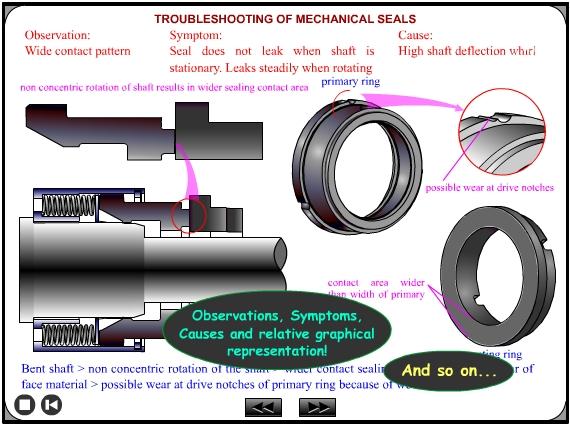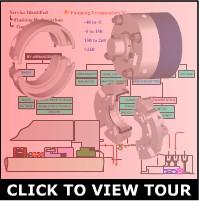Mechanical Seal Basics and Seal Selection Process Training
- Home >
- vocational-training >
- mechanical >
- mechanical seal selection
This training software course, with skills tests, makes a great animated study guide for mechanical seal training software.
This course covers many seal types and related information in the industry.

Tap the above picture to see Mechanical Seals Basics course demo.
Full Mechanical Seal Training Demo - Content
Mechanical seal basics and seal selection procedure training software
ESBN: NN6-1243-6040-pr25
Description: (40 hrs)
The mechanical seal basics training software covers many types of seals.
| Seal types are: | |
| Pusher seals | Non-Pusher seals |
| Cartridge seals | Split seals |
| Double seals | Tandem seals |
| Dry Gas seals | Spring seals |
| Bellow seals | |
It also provides detailed seal classifications.
The heavy use of graphics/animation helps understand mechanical seal operating-working principles and mechanical seal maintenance procedures and aids in seal repair. The training software course provides detailed information on seal installation, assembly, and dismantling. The mechanical seal training program has dedicated modules to assist with seal troubleshooting and seal selection (API 682 Guided Seal Selection Procedure). Animated cutout sections give a deep insight into mechanical seal operation and how mechanical seals work.
- Extensive coverage of seal designs, arrangements, etc.
- API - 682 types, arrangements, and plans.
- 2D/3D graphics, models, and animations.
- An interactive seal selection procedure tool.
- Glossary, Skills Tests, Certificate Printouts.
Who Can Benefit:
Untrained students and maintenance staff will find this training on Positive Displacement Pump helpful. It will boost their knowledge and confidence in maintenance work. Those with prior training may find this program a good refresher. They may also learn important information outside of their original training.
Hardware Lock:
This course is also available using a "Hardware Lock" licensing method. Many users want to use the software on multiple computers. For example, they want to work with it on both their office and home computers. This Hardware Lock method allows users to install the software on as many computers as they like. They only need to enter the key on whichever computer they want to use the software. This copyright method also works great for the classroom environment.
Special Hardware Lock Bonus:
You can also ask us to embed your company logo in the training software for the hardware lock option.(Please note the URL of your company logo in the comments when ordering, or email your logo to us to use this feature.)
We will send an email confirming the order within 24 hours after purchase. If you ordered a downloadable version, check your email. It has the download link and activation code. We send a second email with tracking info if you ordered one of the shippable versions.
Download (1 Installation on 1 PC, Unlimited users, 1 User at a time.) $149
1 Hardware Lock (Unlimited Installations, Unlimited number of PCs, 1 User at a time.) $349
1 Network Hardware Lock (Network Installation, Unlimited number of PCs, 10 Users at a time.) $1049
1 Network Site License (Network Installation, Unlimited Simultaneous PCs and Users) $2100
Schools or companies needing a SCORM version of the above site license, please contact us and request a quote.
Mech. Seal Course Table of Contents
- 1. Mechanical Seal Fundamentals
- 1.1.1. Seal requirements
- 1.1.2. Packed Stuffing Box
- 1.1.3. Simple Mechanical Seal
- 1.1.4. Seal Face Lubrication
- 1.1.5. Sealing points
- 1.2.1. Pusher Seal
- 1.2.2. Non-pusher (Bellow) Seal
- 1.2.3. Pusher seal vs. Non pusher seal
- 1.2.4. API seal types
- 1.3.1. Unbalanced Seals
- 1.3.2. Balanced Seals
- 1.3.3. Mixer Seals
- 1.3.4. High Pressure Seals
- 1.3.5. High Speed Seals
- 1.3.6. Dry Gas Seal
- 1.3.7. Split seal
- 1.4.1. Inside Seals
- 1.4.2. Outside Seals
- 1.4.3. Double Seals
- 1.4.4. Tandem Seals
- 1.4.5. Cartridge Seals
- 1.4.6. API seal arrangements
- 1.1. Fundamentals of Mechanical Seal Operation
- 1.2. Basic Seal Designs
- 1.3. Variation in basic seal designs
- 1.4. Mechanical Seal Arrangements
- 2. Environmental Controls - Popular Seal Flushing & API Plans
- 2.1. Standard Seal Flush Plan 1
- 2.2. Standard Seal Flush Plan 2
- 2.3. Standard Seal Flush Plan 11
- 2.4. Standard Seal Flush Plan 12
- 2.5. Standard Seal Flush Plan 13
- 2.6. Standard Seal Flush Plan 21
- 2.7. Standard Seal Flush Plan 22
- 2.8. Standard Seal Flush Plan 23
- 2.9. Standard Seal Flush Plan 31
- 2.10. Standard Seal Flush Plan 32
- 2.11. Standard Seal Flush Plan 41
- 2.12. Standard Seal Flush Plan 51
- 2.13. Standard Seal Flush Plan 52
- 2.14. Standard Seal Flush Plan 53
- 2.15. Standard Seal Flush Plan 54
- 2.16. Standard Seal Flush Plan 61
- 2.17. Standard Seal Flush Plan 62
- 3. Seal Installation / Operation / Maintenance
- 3.1. Equipment Checkpoints
- 3.2. Seal Checkpoints
- 3.3. Seal Installation
- 3.4. Environmental Controls Installation
- 3.5. Start-up and operation
- 3.6. Seal Maintenance
- 4. Troubleshooting and Failure Analysis
- 4.1. Full contact Pattern
- 4.2. Coning (Negative Rotation)
- 4.3. Thermal Distortion (Positive Rotation)
- 4.4. Mechanical Distortion - Type: 1
- 4.5. Mechanical Distortion - Type: 2
- 4.6. Mechanical Distortion - Type: 3
- 4.7. Thermally Distressed - Type: 1
- 4.8. Thermally Distressed - Type: 2
- 4.9. Thermally Distressed - Type: 3
- 4.10. High Wear and Grooving
- 4.11. Out of Square Matting Ring
- 4.12. Wide Contact Pattern
- 4.13. Eccentric Contact Pattern
- 5. Glossary and Definition of Seal Terms
- 6. Conventional and Interactive Skill Tests with evaluation
- 7. API-682 guided Seal Selection Procedure Tool
Related Products:
Infrared Inspection of Mechanical Systems
Gas and Air Compressor Training Course
Hydraulics Training Certificate Course
Centrifugal Pumps and Troubleshooting Guide
Industrial hydraulic systems and circuits
Hazardous Area Instrumentation Training
Handbook for Machining Equipment Maintenance
PLC training video series (10 DVD set w/ workbook)
Please contact BIN95 with your questions and comments.

